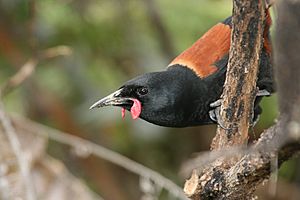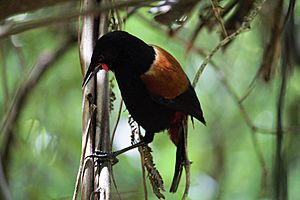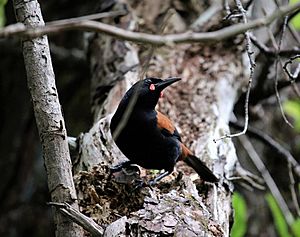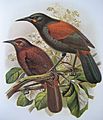Saddleback (bird) facts for kids
Quick facts for kids Saddleback |
|
|---|---|
 |
|
| A North Island saddleback (Philesturnus rufusater) | |
| Scientific classification |
|
| Kingdom: | Animalia |
| Phylum: | Chordata |
| Class: | Aves |
| Order: | Passeriformes |
| Family: | Callaeidae |
| Genus: | Philesturnus I. Geoffroy Saint-Hilaire, 1832 |
| Species | |
|
P. rufusater |
|
The saddlebacks (Māori: tīeke) are two types of New Zealand birds. They belong to a special bird family called Callaeidae. Both saddleback species are shiny black with a reddish-brown patch on their back, which looks like a saddle. This family is also known as the "wattlebirds" because all its members have colorful, fleshy growths called "wattles" on each side of their beak. For saddlebacks, these wattles are a bright red. Other birds in this family include the kōkako and the extinct huia.
Contents
About Saddlebacks
The name "saddleback" comes from the brown patch on their back, which looks just like a horse's saddle. The Māori name, tīeke, sounds like one of the bird's calls: ti-e-ke-ke-ke-ke.
There are two main types of saddlebacks:
- North Island saddleback — Philesturnus rufusater
- South Island saddleback — Philesturnus carunculatus
Saddlebacks are unique birds found only in New Zealand. They are part of a very old group of songbirds that settled in New Zealand a long time ago. They are closely related to the stitchbird, but their exact family tree with other birds is still a bit of a mystery.
Saddleback Behavior and Life
Saddlebacks are larger than many other insect-eating birds in New Zealand forests. They can grow up to 25 cm (10 in) long and weigh about 75 grams. This is a bit bigger than a common blackbird.
These birds are very clever at finding food. They often tear pieces of bark off tree trunks to find insects hiding underneath. They use their short, strong beak to catch and eat the insects. Saddlebacks also look for food on the ground among fallen leaves. Besides insects, they enjoy eating fruit and drinking nectar from flowers.
Saddlebacks are not very good at flying long distances, much like their relatives, the kōkakos. They mostly hop and jump from branch to branch. When they do fly, it's usually for short bursts and can be quite noisy.
Territory and Nesting
Saddlebacks are very protective of their homes and families. They are known as "territorial" birds. They show this in a few ways:
- They sing loudly at dawn to let other birds know where their territory is.
- They might do "threat displays," which include bobbing their heads, fanning their tails, and making warbling sounds. During this time, their red wattles become bigger and brighter.
- If another bird tries to enter their territory, they might even get into a fight, trying to grab each other's wattles.
These birds are quite brave and noisy, which made early explorers in New Zealand very interested in them. Saddlebacks build their nests in different places, like in plants that grow on other trees (called epiphytes), in the tops of tree ferns, or inside holes in tree trunks.
They often build their nests close to the ground. When young saddlebacks leave the nest, they hop around noisily on the ground while their wings get stronger.
Saddlebacks and People
Saddlebacks in Māori Culture
Saddlebacks were very important in traditional Māori beliefs. Their calls were seen as signs or omens. If a saddleback's cry came from the right, it was a good sign. If it came from the left, it was a bad sign.
There's a fun Māori legend that explains why the saddleback has its special brown patch. The story says that Māui, a famous hero, had just finished a big battle to catch the sun. He was very thirsty and asked the tīeke to bring him some water. But the bird pretended not to hear him. Māui got angry and grabbed the bird with his hand, which was still hot from fighting the sun. This left a brown scorch mark across the bird's back, creating the saddle we see today!
Saving the Saddleback
Because saddlebacks often nest near the ground and their young hop around there, they are very easy targets for animals that were brought to New Zealand by people. These animals include mustelids (like stoats and ferrets) and different types of rats. These predators caused both saddleback species to disappear quickly from the main islands of New Zealand.
By the early 1900s, saddlebacks could only be found on two small islands: Hen Island in the north and Big South Cape Island in the south.
In 1963, rats accidentally arrived on Big South Cape Island. They escaped from boats used by people who were collecting birds. The New Zealand wildlife service (now called the Department of Conservation) had to act very quickly to save the saddlebacks. They moved the birds to other safe islands just in time. Sadly, the rats caused other local birds and bats on Big South Cape Island to become extinct.
Since then, saddlebacks have been moved to many island nature reserves all around New Zealand. They have also been moved to special areas on the mainland that are protected by fences to keep predators out. Around 2015, people started seeing saddlebacks and even finding their nests in Polhill Reserve, which is next to the fenced Zealandia wildlife sanctuary. These were the first sightings of saddlebacks on New Zealand's unfenced mainland since they were thought to be extinct there in 1910!
The return of the saddleback is seen as one of New Zealand's biggest success stories in protecting its unique wildlife.
Gallery
-
A saddleback on Ulva Island, a bird sanctuary near Stewart Island.
See also
 In Spanish: Tiekes para niños
In Spanish: Tiekes para niños






